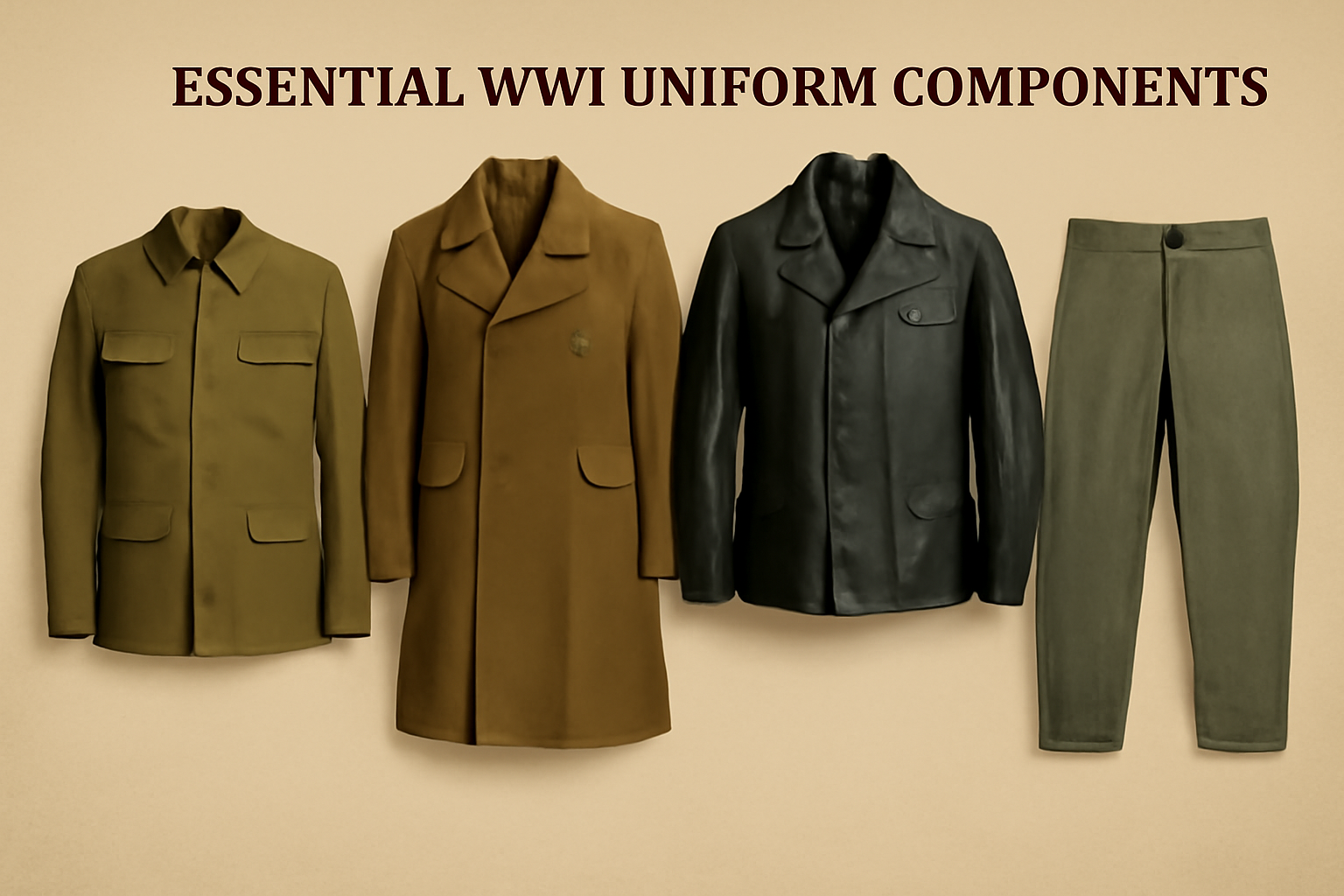
Essential WWI Uniform Components: A Complete Guide to World War One Jackets, Greatcoats, and German WWII Leather Jackets
Published on May 31, 2025
WWI Uniform Components: A Comprehensive Guide to World War One Jackets, Greatcoats, and WWII German Leather Jackets
The uniforms worn by soldiers during World War I represent not only military utility but also the evolution of military fashion and technological adaptation on the battlefield. Understanding the components of WWI uniforms offers a fascinating glimpse into history, culture, and warfare. This guide will focus primarily on the World War One jacket and the WW1 greatcoat while also providing insights into related WWII items like the German leather jacket and German trousers WW2.
The World War One Jacket: Symbol of Early 20th Century Warfare
The World War One jacket was a vital part of a soldier's uniform, designed to balance functionality and protection. Known for its robust fabric and practical design, it provided warmth and some defence against the harsh conditions of trench warfare.
Design and Features
- Material: Typically made from heavy wool to withstand cold weather and trench conditions.
- Cut: Straight cut with a stand-up collar, providing ease of movement.
- Pockets: Multiple pockets for carrying essential items like maps, ammunition, and personal effects.
- Color: Usually in shades of khaki, grey, or green to blend with battlefield environments.
Historical Importance
The WWI jacket reflected the shift from elaborate, ornamental WW2 Military Uniforms to more utilitarian designs driven by the realities of modern industrial warfare. The jacket's practical elements enabled soldiers to endure long periods in the trenches, contributing significantly to their survival and combat effectiveness.
The WW1 Greatcoat: The Soldier's Winter Essential
Alongside the jacket, the WW1 greatcoat was a critical uniform component for cold weather. This heavy, long coat provided insulation and protection against rain, wind, and snow.
Key Characteristics
- Weight: Made from thick wool, heavier than the jacket.
- Length: Extended down to mid-calf or lower to cover most of the body.
- Buttons and Fastenings: Double-breasted design with large buttons for extra warmth and wind protection.
- Functionality: Designed to be layered over the standard uniform for maximum warmth.
Significance
Greatcoats were essential during harsh winters on the Western Front, where freezing temperatures and wet conditions were common. Their durability and warmth made them a favourite among soldiers enduring gruelling conditions.
WWII German Leather Jackets: A Shift Toward Style and Practicality
Moving from WWI to WWII, military uniforms evolved further. The WW2 German leather jacket represents a blend of style, durability, and function, becoming an iconic piece of military apparel.
Features of the German Leather Jacket WW2
- Material: High-quality leather, offering protection and weather resistance.
- Design: Often featuring a fitted waist, epaulettes, and zip or button closures.
- Colour: Typically black or dark brown, symbolizing both authority and practicality.
- Usage: Worn by Luftwaffe pilots, tank crews, and elite troops, balancing ruggedness with a sharp appearance.
The German leather jacket's design influenced post-war fashion and remains highly collectable today.
German Trousers WW2: Completing the Uniform
No uniform is complete without trousers, and German trousers in WW2 were designed with precision and practicality.
Design Aspects
- Material: Durable wool or cotton blends for comfort and longevity.
- Cut: Tailored to allow ease of movement while maintaining a smart appearance.
- Colours: Often matched the jacket or uniform ensemble, usually field grey or other muted tones.
- Features: Reinforced knees and pockets for utility.
These trousers complemented the jackets and greatcoats perfectly, providing soldiers with a complete, functional uniform system.
Why Understanding WWI Uniform Components Matters
Studying the components of WWI uniforms, like the jacket and greatcoat, provides valuable insights into military history, the evolution of warfare gear, and even the socio-cultural aspects of the early 20th century. Collectors and reenactors benefit from knowing these details to authenticate and appreciate uniform pieces.
For history enthusiasts and researchers, the garments tell stories of the soldiers who wore them—their struggles, conditions, and resilience. For modern fashion and design, the practical elements of these uniforms continue to inspire contemporary styles.
Conclusion
The WWI uniform components, especially the World War One jacket and WW1 greatcoat, are more than just pieces of clothing. They embody a significant era of military history marked by innovation, endurance, and adaptation. Transitioning into WWII, items like the German leather jacket and German trousers in WW2 reflect further development in military apparel design.
At paddelaters.com, we celebrate these iconic pieces, providing enthusiasts with authentic and detailed information to deepen their appreciation of military uniforms. Whether you are a collector, reenactor, or simply curious, understanding these components enhances your connection to history and the stories embedded in every stitch.
